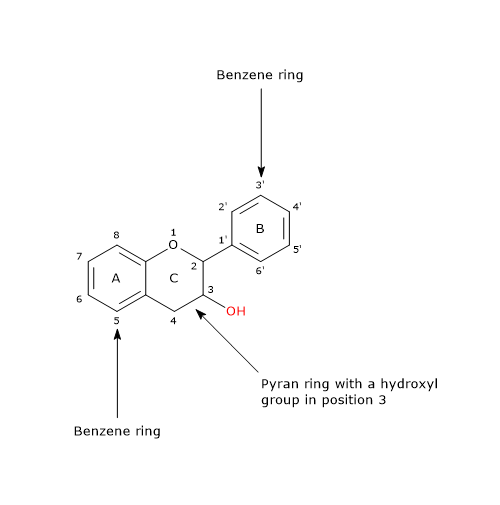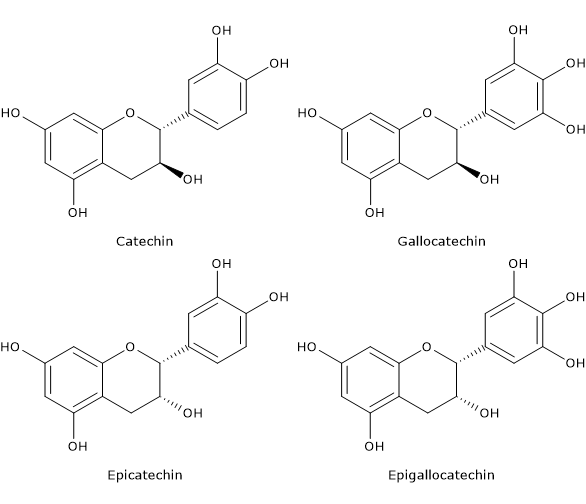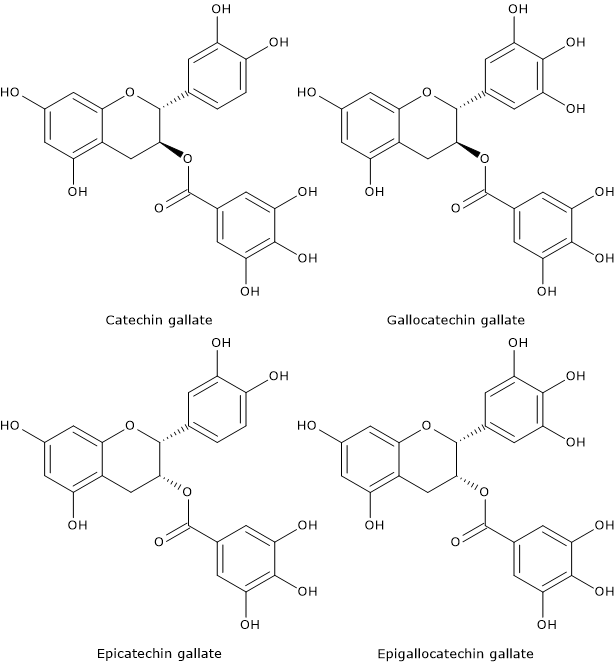Catechins or flavanols, with flavonols such as quercetin, and flavones such as luteolin, are a subgroup of flavonoids among the most widespread in nature.
Flavanols and proanthocyanidins, together with anthocyanins and their oxidation products, are the most abundant flavonoids in human diet.
Contents
Chemical structure
Chemically they differ from many other flavonoids as:
- they lack the double bond between positions 2 and 3 of the C ring;
- they not have a keto group at position 4;
- they have a hydroxyl group in position 3, and for this reason they are also called flavan-3-ols.

Another distinctive feature of flavan-3-ols is their ability to form oligomers, consisting of two to ten units, or polymers, consisting of from eleven or more units up to 60 units, called proanthocyanidins or condensed tannins.
Food sources
Flavanols commonly found in plant-derived food products are catechin, epicatechin, gallocatechin, epigallocatechin, and their gallic acid ester derivatives: catechin gallate, gallocatechin gallate, epicatechin gallate, and epigallocatechin gallate or EGCG.

Flavanols present with higher frequency are catechin and epicatechin, which are also among the most common known flavonoids, and almost as popular as the related flavonol quercetin.
Cocoa and green tea are by far the richest sources in flavanols. In these foods the main flavonoids are catechin and epicatechin, but also their gallic acid ester derivatives, the gallocatechins. Cocoa is also a good source of epigallocatechin.

However, they are also present in many fruits, especially in the skins of apples, blueberries (Vaccinium myrtillus) and grapes, in vegetables, red wine and beer, and peanuts.
As in many cases flavanols are present in the seeds or peels of fruits and vegetables, their intake may be limited by the fact that these parts are discarded during processing or while eaten.
Furthermore, in contrast to other flavonoids, catechins are not glycosylated in foods.
Proanthocyanidins, that is polymeric flavan-3-ols, are also commonly found in plant-derived food products. Their presence has been reported in the skin of peanuts and almonds, as in the berries.
Green and black tea
Green tea is an excellent source of flavonoids. The main flavonoids present in the leaves of the tea, like in cocoa beans, are catechin and epicatechin, monomeric flavanols, together with their gallate derivatives such as EGCG.
Epigallocatechin gallate is the most abundant catechin in green tea and it seems to have an important role in determining green tea benefits, as the reduction of:
- vascular inflammation;
- blood pressure;
- concentration of oxidized LDLs.
Black tea, which is a fermented tea, contains fewer monomeric flavanols, as they are oxidized during fermentation of the leaves to more complex polyphenols such as theaflavins, specifically theaflavin digallate, theaflavin-3-gallate, and theaflavin-3′-gallate, which are all dimers, and thearubigins, which are polymers.
Theaflavins and thearubigins are present only in the tea. Their concentrations in brewed tea are between 50- and 100-folds lesser than in tea leaves.
It should be noted that tea epicatechins are remarkably stable to heat in acidic environment: at pH 5, only about 15% is degraded after seven hours in boiling water (therefore, adding lemon juice to brewed tea does not cause any reduction in their content).
Cocoa and cocoa products
Cocoa has the highest content of polyphenols and flavanols per serving, a concentration greater than those found in green tea and red wine. Most of the flavonoids present in cocoa beans and derived products, such as black chocolate, are catechin and epicatechin, monomeric flavanols, but also epigallocatechin, and their derivatives such as the gallocatechins; among polymers, proanthocyanidins are also important.
Fruits, vegetables, and legumes
Catechin and epicatechin are the main flavanols in fruits. They are found in many fruits in different concentrations, respectively, between 5-3 and 0.5-6 mg/100 g fresh weight.
On the contrary, gallocatechin, epicatechin gallate, epigallocatechin, and epigallocatechin gallate are present in various fruits such as red grapes, berries, apples, peaches and plums, but in very low concentrations, less than 1mg/100 g fresh weight.
Except for lentils and broad beans, few legumes and vegetables contain catechins, and in very low concentrations, less than 1.5 mg/100 g fresh weight.
References
- de la Rosa L.A., Alvarez-Parrilla E., Gonzàlez-Aguilar G.A. Fruit and vegetable phytochemicals: chemistry, nutritional value, and stability. 1th Edition. Wiley J. & Sons, Inc., Publication, 2010
- de Pascual-Teresa S., Moreno D.A. and García-Viguera C. Flavanols and anthocyanins in cardiovascular health: a review of current evidence. Int J Mol Sci 2010;11:1679-1703. doi:10.3390/ijms11041679
- Han X., Shen T. and Lou H. Dietary polyphenols and their biological significance. Int J Mol Sci 2007;9:950-988. doi:10.3390/i8090950
- Manach C., Scalbert A., Morand C., Rémésy C., and Jime´nez L. Polyphenols: food sources and bioavailability. Am J Clin Nutr 2004;79(5):727-747. doi:10.1093/ajcn/79.5.727
- Tsao R. Chemistry and biochemistry of dietary polyphenols. Nutrients 2010;2:1231-1246. doi:10.3390/nu2121231